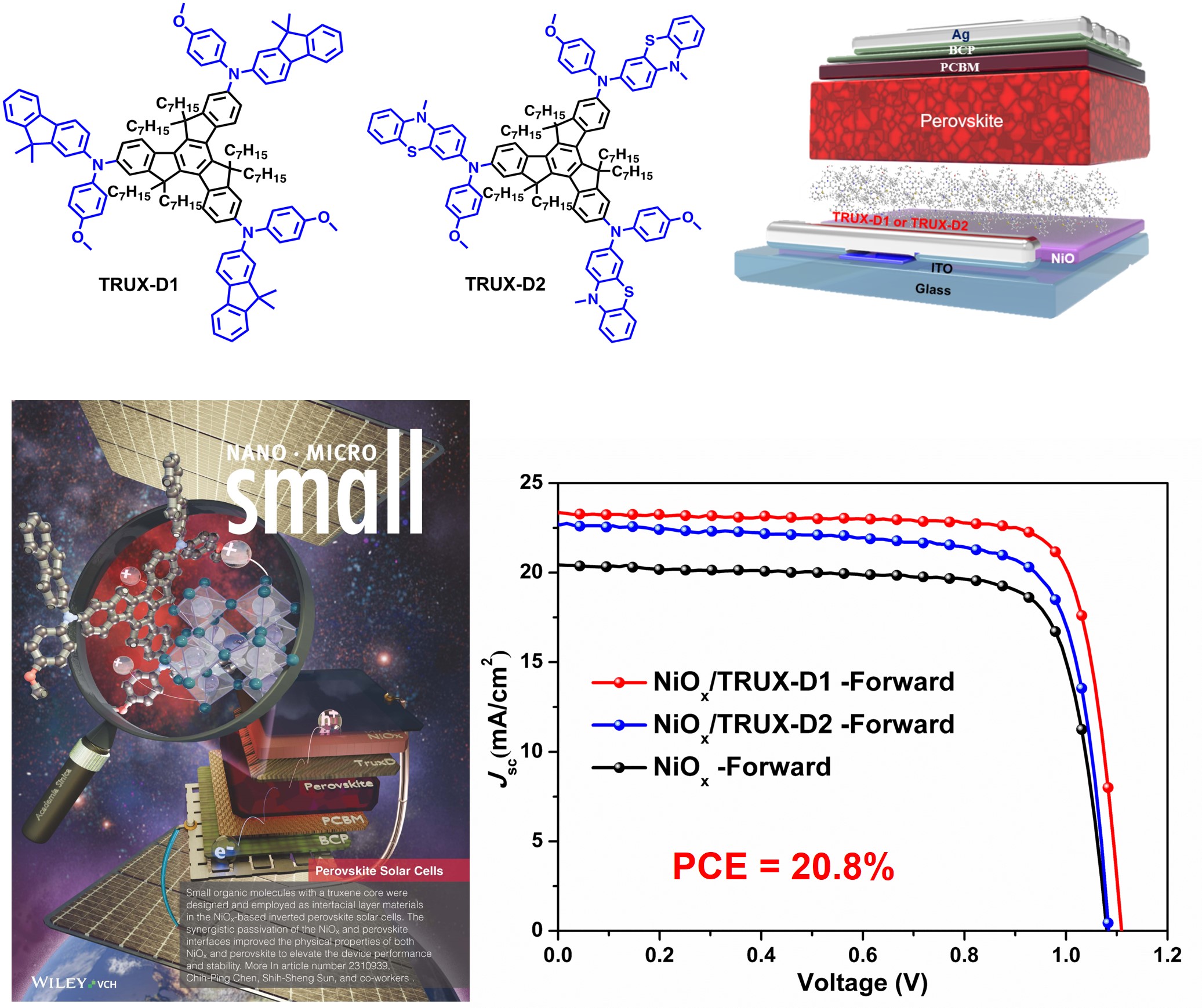Institute of Chemistry, Academia Sinica – Research
以參茚并苯衍生物做為鈣鈦礦太陽能電池中氧化鎳與鈣鈦礦之介面層材料
Interfacial Layer Materials with a Truxene Core for Dopant-Free NiOx-Based Inverted Perovskite Solar Cells
Small 2024, 20, 2310939.Rajarathinam Ramanujam, Hsiang-Lin Hsu, Zhong-En Shi, Chien-Yu Lung, Chin-Han Lee, Gebremariam Zebene Wubie
Chih-Ping Chen,* Shih-Sheng Sun*

在本研究中,我們設計了兩種以參茚并苯為結構核心,並於結構外圍連結具有推電子能力的胺基團所形成之TRUX-D1 和 TRUX-D2分子。這些具有C3對稱星形架構的分子,係經由 Buchwald-Hartwig 之 C-N 偶聯反應所合成。這些 TRUX-D 分子展現了調整 NiOx 能距、增強電荷傳輸特性以及改善熱穩定性的能力。具體來說,透過 TRUX-D 分子中的氮原子與 Pb(II) 空位的配位, NiOx 和鈣鈦礦層間的缺陷被有效地鈍化。因此,具有 ITO/NiOx/TRUX-D1/MAPbI3/PCBM/BCP/Ag 元件組態的p-i-n鈣鈦礦太陽能電池,可達到20.8%的最高功率轉換效率,其效率遠高於未使用TRUX-D界面層材料的對照元件。此外,以 TRUX-D1 為基底的元件展現了顯著的長期穩定性,在手套箱中放置210天後,仍能保持98%的初始效率,而在25 °C及相對濕度超過40%的空氣條件下放置80天後,未封裝元件仍能保持75.5%的初始效率。儘管在封裝與未封裝條件下達到長期穩定性仍是鈣鈦礦太陽能電池面臨的重大挑戰,我們的研究成果顯示基於 MAPbI3 的 p-i-n 型鈣鈦礦太陽能電池已達到迄今所報告的最高效率之一。
In this study, we designed two truxene-based derivatives, TRUX-D1 and TRUX-D2, featuring electron-donating amino groups attached to their peripheral positions. The molecules, with a C3 symmetric star-shaped molecular framework, were synthesized using Buchwald-Hartwig C-N coupling reactions. These TRUX-D molecules demonstrated the ability to tune the energy level of NiOx, enhance charge transport properties, and improve thermal stability. Specifically, the NiOx and perovskite defects were effectively passivated through the coordination of the nitrogen atoms in the TRUX-D molecules to Pb(II) vacancies. As a result, MAPbI3-based p-i-n devices with a configuration of ITO/NiOx/TRUX-D1/MAPbI3/PCBM/BCP/Ag achieved a champion power conversion efficiency (PCE) of 20.8%, significantly higher than the 17.2% PCE observed in the control device without the interfacial layer material. Moreover, TRUX-D1-based devices exhibited remarkable long-term stability, retaining 98% of the initial PCE after 210 days in a glove box and 75.5% of the initial PCE after 80 days under ambient air condition with humidity over 40% at 25 °C for the unencapsulated device. While achieving long-term stability under encapsulated and unencapsulated conditions remains a significant challenge for PSCs, these results represent one of the highest reported PCEs for MAPbI3-based p-i-n type PSCs to date.
